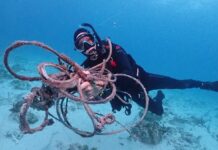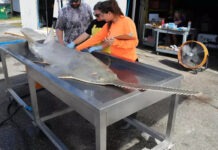On Nov. 17, the Monroe County Commission took a very hard look at its finances. The timing coincides with the revelation of the $1.8 billion price tag to address the Keys’ sea level rise anticipated in 25 years — the year 2045.
Yes, billion with a “b.” That’s the amount officials forecast it will cost to raise roads and move utilities (and finance the financing) to protect neighborhoods that are vulnerable should there be a 1-foot rise in sea level.
The commission heard a number of reports outlining the county’s financial options: a public bond, sales tax increases, homeowner assessments and grants and loans that could be available. The comprehensive approach came a day ahead of a special meeting to figure out which roads should be prioritized for reconstruction.
Sergio Masvidal of PFM Consulting told the commissioners it was unlikely that any one of the options would provide the financial resiliency the county needs to cope with sea level rise expenses. Rather, he said, a varied approach would be necessary, something his firm calls a Green Bond Toolbox.
• Public bonds. Municipal bonds are essentially loans taken out by states, cities or counties to finance capital projects such as road elevations. Monroe County doesn’t have a bond credit rating because it hasn’t taken any types of these loans. According to PFM, a financial consultant for the county, Monroe County could qualify for a favorable AA rating.
“That’s an extremely strong rating,” said PFM’s Sergio Masvidal. “Technically, the county has a bonding capacity of $400 million.”
An ad-valorem bond issued on the worth of Keys real estate ($28 billion), assessed at one mill over 30 years with an interest rate of 5% would require an annual debt service payment of about $647,000 in order to raise $10 million. Homeowners with a house valued at just under $400,000 would pay an extra $10 per year. If the county wanted $100 million, that same homeowner would pay about $100 per year. Of course, either $10 million or $100 million is way off the mark of the needed $1.8 billion to raise the roads but, Masvidal said, it helped to illustrate the number crunching.
• Sales tax. In Monroe County, elected officials could go two ways by implementing a sales tax — add an extra penny, or extend the existing infrastructure tax beyond its sunset in 2023 and continue to collect money that would be used to elevate roads.
Masvidal told the commission that in Miami, officials found an “elegant” way to raise the funds by extending an existing sales tax to fund the Miami Forever Program — $300 million to address sea level rise and $100 million in housing and economic development.
Or, the county could choose to add an additional penny to local sales tax, raising it from 7.5 cents to 8.5 cents.
Both of these options would require legislative approval from Tallahassee before they could then be presented to voters in a referendum. County Administrator Roman Gastesi warned it’s not guaranteed state officials would agree to it.
“It’s a big lift,” Gastesi said.
• Grants and loans. Masvidal also presented some funding options including the federal government’s Water Infrastructure Finance and Innovation Act designed to provide low interest rates and flexible repayment terms. That loan covers up to 49% of eligible projection costs. He also mentioned New Orleans’ strategy: accept federal funds and then set up a local revolving loan program where homeowners could apply and repay for improvements needed to address water inundation.
• Assessments. Much like the county’s approach to sewering the Keys, the Keys would be divided into districts with homeowners in each neighborhood paying an assessment. (In Marathon, for example, homeowners paid a $5,000 assessment to connect to the municipal wastewater system. That could be paid upfront, or in annual installments on the tax bill with interest tacked on.)
In fact, there are two pilot projects Monroe County is moving forward with that would use the assessment model (see sidebar).
“Looking at our fundraising ability as opposed to the anticipated expenditure for seal level rise … well, the figures don’t match very well,” said Commissioner David Rice. “Our target is currently $1.8 billion. What we’re talking about here would depend on a significant amount of ‘OPM’ — Other People’s Money.”
* * * *
There were some bright spots amid all these data points, delivered by Hank Fishkind, also of PFM Consulting, who looked at the county’s overall financial picture amid the coronavirus-induced recession.
One, Monroe County’s recovery and projected recovery is outperforming other tourist destinations including Orlando, Florida (Disney World) and Anaheim, California (Disneyland). Two, the pandemic revealed how much of the sales tax is paid for by tourists, and it’s much higher than anticipated.
“We’ve always guessed that visitors pay 50 to 55% of our infrastructure tax. In recent years, we’ve increased that to about 60%,” said Gastesi.
In fact, Fishkind said it’s more like 67%. The numbers were derived from the drop in sales tax and gas tax during May when the Keys were closed to visitors.


























